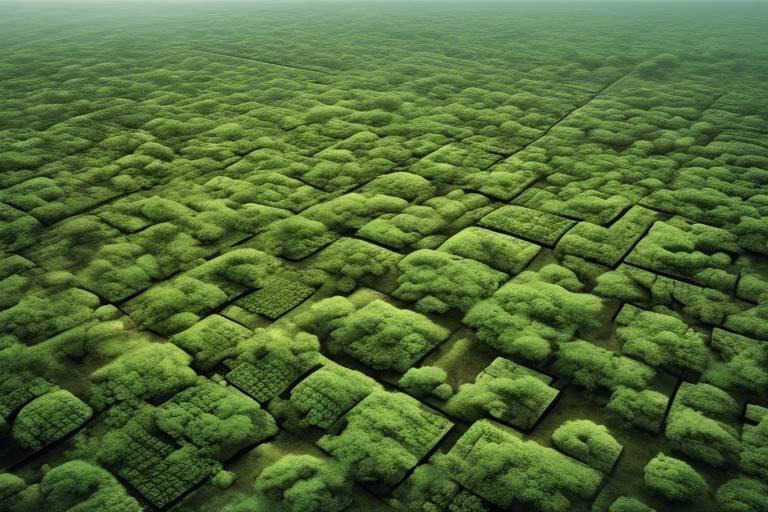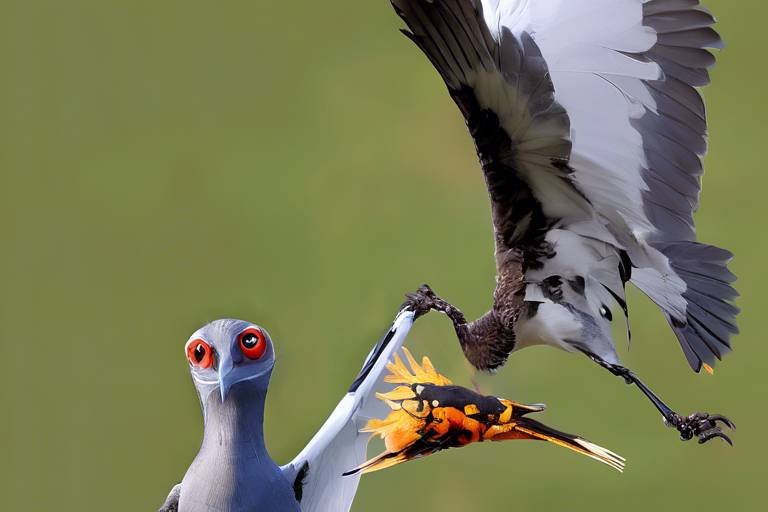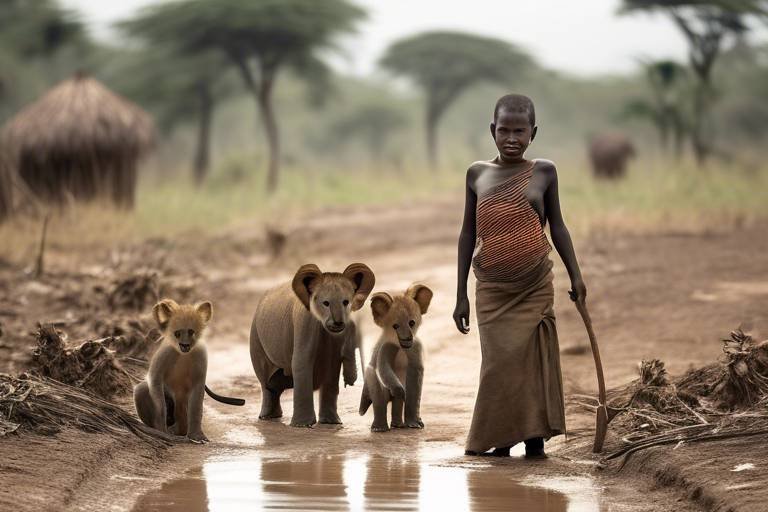The Role of Biodiversity in Mitigating Climate Change
This article explores the crucial relationship between biodiversity and climate change, highlighting how diverse ecosystems contribute to climate resilience, carbon sequestration, and overall environmental health. In a world where climate change looms larger every day, the significance of biodiversity cannot be overstated. Think of biodiversity as the intricate web of life that sustains our planet; it’s not just a collection of different species but a vital component that holds the key to our environmental future.
Biodiversity is vital for ecosystem stability and resilience. It provides essential services that support life, including clean air, water purification, and pollination, all of which are critical in combating climate change. Imagine a world without bees; our food systems would collapse, and our diets would suffer tremendously. This is just one example of how interconnected life forms are, where the loss of one can lead to a domino effect impacting many others.
Ecosystems offer various services that help regulate the climate. These include carbon storage, nutrient cycling, and water management, which are essential for maintaining ecological balance and mitigating climate impacts. For instance, forests act as carbon sinks, absorbing CO2 and releasing oxygen, while wetlands filter pollutants and manage floodwaters. Without these natural services, our planet would face dire consequences.
Forests play a significant role in carbon sequestration by absorbing CO2 from the atmosphere. Protecting and restoring forests can thus significantly reduce greenhouse gas emissions and enhance climate stability. To put it simply, forests are our planet's lungs, filtering the air we breathe and helping to combat climate change. The loss of these vital ecosystems not only releases stored carbon but also diminishes our capacity to absorb future emissions.
Wetlands are crucial for carbon storage and flood regulation. They act as natural buffers against climate change impacts, helping to maintain biodiversity and protect coastal areas from rising sea levels. Think of wetlands as nature's sponges; they soak up excess water during storms and release it slowly, preventing floods while also providing habitats for countless species. Their importance in climate resilience cannot be overstated.
Grasslands also contribute to carbon sequestration. Their deep-root systems store carbon in the soil, making them essential for climate mitigation efforts and supporting diverse wildlife. These vast expanses of grass are not just pretty landscapes; they are powerful carbon sinks that help to regulate the Earth's climate. By preserving and restoring grasslands, we can enhance their ability to store carbon and support the diverse species that call them home.
A diverse range of species enhances ecosystem resilience, allowing ecosystems to adapt to changing climates. This diversity helps prevent ecosystem collapse and ensures the continued provision of essential services. Picture a jigsaw puzzle; if one piece is missing, the whole picture is affected. Similarly, when species are lost, the entire ecosystem's functionality is compromised, making it less capable of withstanding climate stressors.
Effective conservation strategies are vital for preserving biodiversity. These strategies can include habitat restoration, protected areas, and sustainable land management practices that promote ecological health and climate resilience. By implementing these strategies, we can create a more sustainable future where both people and nature can thrive together.
Engaging local communities in conservation efforts fosters stewardship and enhances biodiversity protection. Community-led initiatives can lead to sustainable practices that benefit both the environment and local livelihoods. When people are involved in protecting their natural surroundings, they develop a deeper connection to the land, which translates to better conservation outcomes. It's a win-win situation!
Strong policies and legislation are necessary to protect biodiversity. Governments must prioritize biodiversity in climate action plans to ensure ecosystems remain resilient in the face of climate change. Think of policies as the framework that supports our conservation efforts; without them, our initiatives may lack direction and effectiveness. By advocating for robust environmental laws, we can secure a healthier planet for future generations.
- What is biodiversity? Biodiversity refers to the variety of life on Earth, including the different species, genetic variations, and ecosystems.
- How does biodiversity help mitigate climate change? Biodiversity enhances ecosystem resilience, aids in carbon sequestration, and provides essential services that regulate climate.
- What can individuals do to help preserve biodiversity? Individuals can help by supporting conservation efforts, reducing waste, and advocating for sustainable practices in their communities.

The Importance of Biodiversity
Biodiversity is not just a buzzword; it's the backbone of our planet's health and stability. Imagine a world where every species plays a unique role, like instruments in a grand symphony. Each organism, from the tiniest microbe to the largest mammal, contributes to the ecosystem's functionality. Without this intricate web of life, the music of our environment would fall silent, leading to chaos and imbalance.
Why is biodiversity so crucial? Well, it provides us with essential services that are vital for our survival and well-being. These services include:
- Clean Air: Trees and plants filter pollutants, providing us with the fresh air we need to breathe.
- Water Purification: Wetlands and forests act as natural filters, cleaning our water supply and ensuring its quality.
- Pollination: Bees, birds, and other pollinators are essential for the reproduction of many plants, including those we rely on for food.
Each of these services is interconnected, showcasing how biodiversity works in harmony to create a stable environment. For instance, healthy forests not only purify air and water but also support a myriad of species that contribute to the ecosystem's resilience. Think of biodiversity as a safety net; the more diverse the species, the stronger the net becomes, protecting us from the impacts of climate change.
Moreover, biodiversity enhances ecosystem resilience. When faced with challenges like climate change, disease, or natural disasters, ecosystems with a rich variety of species can adapt and recover more effectively. This adaptability is crucial in a world where environmental conditions are rapidly changing. A diverse ecosystem can withstand and bounce back from disturbances, ensuring that essential services continue to be provided.
In summary, biodiversity is not just about the number of species; it's about the relationships and interactions that sustain life on Earth. By recognizing the importance of biodiversity, we can better appreciate the role it plays in mitigating climate change and supporting a healthy planet for future generations. Protecting biodiversity is not merely an environmental concern; it is a fundamental necessity for our survival and well-being.

Ecosystem Services and Climate Regulation
Ecosystems are like the unsung heroes of our planet, quietly working behind the scenes to regulate the climate and maintain balance. These natural systems provide a wealth of ecosystem services that are crucial in the fight against climate change. From regulating the atmosphere to maintaining water quality, the services offered by ecosystems are indispensable. They act as natural buffers, helping to mitigate the impacts of climate fluctuations and ensuring that life can thrive.
One of the primary ways ecosystems contribute to climate regulation is through carbon storage. Forests, wetlands, and grasslands all play significant roles in capturing and storing carbon dioxide (CO2) from the atmosphere. For instance, forests are often referred to as the "lungs of the Earth," as they absorb vast amounts of CO2 during photosynthesis and store it in their biomass and soil. This process not only reduces greenhouse gas concentrations but also helps to stabilize the climate.
Additionally, ecosystems contribute to nutrient cycling, which is essential for maintaining soil fertility and promoting plant growth. Healthy soils rich in organic matter can store more carbon, further enhancing their ability to mitigate climate change. Wetlands, for example, are incredibly efficient at nutrient cycling, filtering pollutants and improving water quality while also sequestering carbon. By maintaining these ecosystems, we can ensure they continue to provide these vital services.
Water management is another critical ecosystem service that directly influences climate regulation. Ecosystems like forests and wetlands help to manage the water cycle by absorbing excess rainfall, reducing runoff, and replenishing groundwater supplies. This not only protects against flooding but also ensures a stable water supply during droughts. The interconnectedness of these services highlights the importance of preserving biodiversity; a diverse range of species ensures that ecosystems can adapt and continue to function effectively, even in the face of climate change.
To illustrate the various ecosystem services and their contributions to climate regulation, consider the following table:
| Ecosystem Type | Key Services | Climate Regulation Role |
|---|---|---|
| Forests | Carbon storage, oxygen production, habitat provision | Absorb CO2, regulate temperature |
| Wetlands | Water filtration, flood control, habitat for wildlife | Store carbon, mitigate flooding |
| Grasslands | Nutrient cycling, soil erosion prevention, habitat for species | Store carbon in deep roots, enhance soil health |
In conclusion, the intricate web of ecosystem services provided by our planet's natural systems is vital for climate regulation. By understanding and valuing these services, we can better appreciate the role of biodiversity in mitigating climate change. It's not just about saving the cute animals or beautiful landscapes; it's about preserving the very systems that support life on Earth. When we take action to protect these ecosystems, we are investing in a sustainable future for ourselves and generations to come.
- What are ecosystem services? Ecosystem services are the benefits that humans derive from natural ecosystems, including clean air, water purification, and climate regulation.
- How do ecosystems help mitigate climate change? Ecosystems help mitigate climate change by sequestering carbon, regulating water cycles, and providing essential nutrients for plant growth.
- Why is biodiversity important for ecosystem services? Biodiversity enhances the resilience of ecosystems, allowing them to adapt to changes and continue providing essential services even under stress.

Forests are often referred to as the planet's lungs, and for good reason. They play a crucial role in carbon sequestration, absorbing carbon dioxide (CO2) from the atmosphere and storing it in their biomass and soils. This natural process is essential in combating climate change, as it helps to mitigate the effects of greenhouse gas emissions. When we think about forests, we should visualize vast expanses of trees, rich biodiversity, and complex ecosystems working in harmony to provide us with clean air and a stable climate.
But how exactly do forests achieve this remarkable feat? Let's break it down:
- Photosynthesis: Trees absorb CO2 during photosynthesis, converting it into oxygen and organic matter. This process not only cleans our air but also contributes to the growth of the tree itself, which stores carbon in its trunk, branches, and leaves.
- Soil Carbon Storage: The soil beneath forests is a major carbon reservoir. As trees shed leaves and branches, organic matter decomposes, enriching the soil with carbon. Healthy soils can store up to three times more carbon than the atmosphere.
- Biodiversity Support: Diverse forest ecosystems are more resilient to climate change. They can adapt to changing conditions, which ensures continued carbon storage and ecosystem health.
In addition to these mechanisms, forests also provide a host of other benefits that contribute to climate resilience. For instance, they regulate local temperatures, maintain water cycles, and protect against soil erosion. All these factors create a robust environment that not only supports wildlife but also helps communities adapt to climate impacts.
However, the reality is that forests are under threat from deforestation, urbanization, and climate change itself. According to recent studies, we are losing approximately 10 million hectares of forest each year. This loss not only releases stored carbon back into the atmosphere but also diminishes the planet's capacity to absorb future emissions. Therefore, protecting and restoring forests is not just an environmental necessity; it is a critical strategy for climate action.
To combat these challenges, various initiatives are being undertaken globally. For example, reforestation projects aim to restore degraded areas, while afforestation efforts focus on planting trees in non-forested areas. Both strategies are effective in enhancing carbon sequestration. Moreover, sustainable forest management practices ensure that forest resources are used responsibly, balancing ecological health with economic needs.
In conclusion, the significance of forests in carbon sequestration cannot be overstated. They are not merely trees; they are complex ecosystems that play a vital role in maintaining our planet's climate. By prioritizing forest conservation and restoration, we can enhance our ability to combat climate change effectively. So, the next time you take a breath of fresh air, remember the forests working tirelessly behind the scenes to keep our planet healthy and thriving.
Q1: How much carbon can a single tree absorb?
A single mature tree can absorb approximately 48 pounds of carbon dioxide per year. Over its lifetime, it can sequester over a ton of CO2!
Q2: What are the main threats to forests?
The primary threats include deforestation for agriculture, logging, urban development, and climate change impacts such as wildfires and pests.
Q3: What can individuals do to help protect forests?
Individuals can contribute by supporting sustainable products, participating in tree planting initiatives, and advocating for policies that protect forested areas.

The Role of Wetlands
Wetlands are often referred to as the Earth's kidneys because of their incredible ability to filter pollutants and improve water quality. These unique ecosystems, which include marshes, swamps, and bogs, are not just beautiful landscapes; they play a crucial role in combating climate change. By acting as natural sponges, wetlands absorb excess rainwater, reducing the risk of floods and helping to maintain the water cycle. Imagine a sponge soaking up water – that's what wetlands do for our environment!
One of the most significant benefits of wetlands is their capacity for carbon storage. They store more carbon per unit area than any other ecosystem type, which is essential in mitigating greenhouse gas emissions. Wetlands achieve this through the accumulation of organic matter in their waterlogged soils, which slows down the decomposition process. As a result, carbon is sequestered in the soil, preventing it from entering the atmosphere. This makes wetlands invaluable in the fight against climate change.
Moreover, wetlands serve as natural buffers against the impacts of climate change. They help protect coastal areas from rising sea levels by absorbing storm surges and reducing erosion. This is particularly important in regions vulnerable to extreme weather events. Wetlands also support a diverse range of wildlife, providing habitat for numerous species, including migratory birds and aquatic life. The biodiversity found in wetlands is essential not only for ecological balance but also for human livelihoods, as many communities rely on these ecosystems for fishing, recreation, and tourism.
However, wetland ecosystems face significant threats from urbanization, agriculture, and climate change itself. It's crucial to prioritize their conservation and restoration. Protecting wetlands involves implementing sustainable land management practices, creating protected areas, and engaging local communities in conservation efforts. By doing so, we can ensure that these vital ecosystems continue to provide their numerous benefits for generations to come.
In summary, wetlands play a multifaceted role in climate change mitigation and adaptation. Their capacity for carbon storage, flood regulation, and biodiversity support makes them indispensable in our efforts to create a more resilient environment. As we move forward, it is essential to recognize the importance of wetlands and take action to protect and restore them.
- What are wetlands? Wetlands are areas where water covers the soil, either permanently or seasonally, and include marshes, swamps, and bogs.
- How do wetlands help with climate change? Wetlands sequester carbon, filter pollutants, and regulate water flow, making them critical in mitigating climate change effects.
- Why are wetlands important for biodiversity? Wetlands provide habitat for various species, supporting rich biodiversity that is essential for ecological balance.
- What threats do wetlands face? Wetlands are threatened by urban development, agricultural practices, pollution, and climate change.

Grasslands, often overlooked in discussions about climate change, play a critical role in carbon storage. These vast expanses of land, characterized by their rich biodiversity and deep-rooted vegetation, act as significant carbon sinks. The deep root systems of grassland plants not only anchor the soil but also help sequester carbon deep underground. This process is essential for climate mitigation efforts, as it effectively removes carbon dioxide from the atmosphere, reducing the greenhouse gas concentration that contributes to global warming.
Interestingly, the carbon stored in grasslands can be several times greater than that found in forests. This is largely due to the extensive root systems that can reach depths of up to three meters or more. These roots not only store carbon but also improve soil structure and health, leading to enhanced water retention and nutrient cycling. In fact, healthy grasslands can store approximately 1.5 billion metric tons of carbon globally each year.
Moreover, grasslands support a diverse array of wildlife, which contributes to ecosystem stability. This biodiversity is vital because it allows ecosystems to adapt to changing conditions, making them more resilient to climate impacts. When grasslands are healthy and diverse, they can better withstand droughts, floods, and other extreme weather events caused by climate change. As such, protecting and restoring grasslands is not just about preserving nature; it’s about safeguarding our future.
In addition to their carbon storage capabilities, grasslands also provide numerous ecosystem services, including:
- Soil Fertility: Grasslands contribute to nutrient cycling, enhancing soil fertility and promoting agricultural productivity.
- Water Regulation: They play a role in maintaining the hydrological cycle, helping to manage water resources and reduce flooding.
- Biodiversity Habitat: Grasslands serve as habitats for various species, supporting biodiversity that is crucial for ecosystem health.
To maximize the carbon storage potential of grasslands, sustainable land management practices must be implemented. This includes controlled grazing, restoration of degraded lands, and the promotion of native plant species. These practices not only enhance carbon sequestration but also improve the overall health of the ecosystem, ensuring that grasslands continue to thrive in the face of climate change.
- What is carbon sequestration?
Carbon sequestration is the process of capturing and storing atmospheric carbon dioxide. Grasslands play a significant role in this process through their deep root systems. - How do grasslands contribute to climate resilience?
Diverse grasslands enhance ecosystem resilience by providing habitats for various species, which helps ecosystems adapt to changing climates. - What can be done to protect grasslands?
Implementing sustainable land management practices, restoring degraded areas, and promoting biodiversity are essential steps in protecting grasslands.

This article explores the crucial relationship between biodiversity and climate change, highlighting how diverse ecosystems contribute to climate resilience, carbon sequestration, and overall environmental health.
Biodiversity is vital for ecosystem stability and resilience. It provides essential services that support life, including clean air, water purification, and pollination, all of which are critical in combating climate change.
Ecosystems offer various services that help regulate the climate. These include carbon storage, nutrient cycling, and water management, which are essential for maintaining ecological balance and mitigating climate impacts.
Forests play a significant role in carbon sequestration by absorbing CO2 from the atmosphere. Protecting and restoring forests can thus significantly reduce greenhouse gas emissions and enhance climate stability.
Wetlands are crucial for carbon storage and flood regulation. They act as natural buffers against climate change impacts, helping to maintain biodiversity and protect coastal areas from rising sea levels.
Grasslands also contribute to carbon sequestration. Their deep-root systems store carbon in the soil, making them essential for climate mitigation efforts and supporting diverse wildlife.
When we talk about biodiversity and its role in resilience to climate change, we're essentially highlighting how a rich variety of species can act like a safety net for ecosystems. Imagine a well-stocked toolbox: when something breaks, having multiple tools available means you can fix it quickly and efficiently. Similarly, diverse ecosystems can adapt more readily to environmental changes, making them less vulnerable to extreme weather events and other climate-related stresses.
This resilience is primarily due to the different functions that various species perform within an ecosystem. For instance, some plants may be more drought-resistant, while others thrive in wet conditions. When these species coexist, they create a balanced environment that can withstand fluctuating climatic conditions. Moreover, biodiversity enhances the capacity of ecosystems to recover from disturbances. Think of it as a team of athletes—each player has unique strengths, and together they can tackle challenges more effectively than a single player could on their own.
Research has shown that ecosystems with high biodiversity are better equipped to handle changes. For example, a study demonstrated that a diverse coral reef is more likely to survive bleaching events than a homogenous one. This adaptability is crucial as we face increasing temperatures and unpredictable weather patterns. Thus, protecting biodiversity isn't just about saving cute animals and beautiful plants; it's about ensuring that our ecosystems can continue to function and provide us with the services we rely on, such as clean air, water, and food.
In summary, biodiversity acts as a buffer, enhancing the resilience of ecosystems against the impacts of climate change. By maintaining a diverse range of species, we can help ensure that our natural environments remain robust and capable of supporting life in an ever-changing world.
Effective conservation strategies are vital for preserving biodiversity. These strategies can include habitat restoration, protected areas, and sustainable land management practices that promote ecological health and climate resilience.
Engaging local communities in conservation efforts fosters stewardship and enhances biodiversity protection. Community-led initiatives can lead to sustainable practices that benefit both the environment and local livelihoods.
Strong policies and legislation are necessary to protect biodiversity. Governments must prioritize biodiversity in climate action plans to ensure ecosystems remain resilient in the face of climate change.
- What is biodiversity? Biodiversity refers to the variety of life on Earth, including the different species of plants, animals, and microorganisms, as well as the ecosystems they form.
- How does biodiversity help combat climate change? Biodiversity enhances ecosystem resilience, supports carbon sequestration, and provides essential services that mitigate the impacts of climate change.
- Why should we care about conserving biodiversity? Conserving biodiversity is crucial for maintaining ecosystem services, supporting human well-being, and ensuring that ecosystems can adapt to changing environmental conditions.
- What can individuals do to help preserve biodiversity? Individuals can help by supporting conservation efforts, reducing waste, planting native species, and advocating for policies that protect natural habitats.

When it comes to conservation strategies for biodiversity, we need to think of them as the lifelines that keep our ecosystems healthy and resilient. Just like a well-tuned orchestra, each species plays its part in maintaining the harmony of our environment. Without these strategies, we risk creating dissonance that could lead to ecological collapse. So, what are the most effective ways to preserve our precious biodiversity? Let's dive into a few key strategies that can make a real difference.
One of the most effective methods for conserving biodiversity is through habitat restoration. This involves rehabilitating degraded ecosystems to restore their natural functions and services. For example, reforesting areas that have been deforested not only helps in carbon sequestration but also provides a home for countless species. Similarly, restoring wetlands can enhance water quality and provide critical habitats for aquatic life. The process might seem daunting, but it’s akin to giving nature a second chance to thrive.
Another vital strategy is the establishment of protected areas. These are regions set aside specifically to conserve wildlife and their habitats. Think of them as nature’s safe havens, where ecosystems can flourish without the pressures of human activity. According to the International Union for Conservation of Nature (IUCN), protecting at least 30% of our planet’s land and oceans is crucial for halting biodiversity loss. This approach not only safeguards species but also ensures that ecosystems continue to provide essential services for future generations.
Moreover, sustainable land management practices are essential for promoting ecological health and climate resilience. By adopting practices that minimize environmental impact, such as agroforestry and organic farming, we can enhance biodiversity while still meeting our food and resource needs. These practices are like a balancing act, ensuring that we don’t tip the scales too far in favor of industrialization at the expense of our natural world.
Incorporating community involvement in conservation efforts is another powerful strategy. Engaging local communities in protecting their natural resources fosters a sense of ownership and stewardship. When people understand the value of biodiversity, they are more likely to participate in conservation initiatives. Community-led projects, such as local wildlife reserves or sustainable fishing practices, can lead to significant improvements in biodiversity while also benefiting local economies. It’s a win-win situation that empowers individuals and strengthens ecosystems.
Lastly, we cannot overlook the importance of policy and legislation for biodiversity protection. Strong, enforceable laws are necessary to ensure that conservation efforts are not just temporary fixes but part of a long-term strategy. Governments must prioritize biodiversity in their climate action plans and commit to international agreements aimed at protecting ecosystems. Think of legislation as the framework that supports all other conservation strategies; without it, our efforts may falter.
In conclusion, the conservation of biodiversity is a multifaceted challenge that requires a combination of strategies. From habitat restoration to community involvement, each approach contributes to a larger goal: a healthier planet. If we can learn to work in harmony with nature, we can preserve the rich tapestry of life that sustains us all.
- What is biodiversity? Biodiversity refers to the variety of life on Earth, including the diversity of species, ecosystems, and genetic variations within species.
- Why is biodiversity important? Biodiversity is crucial for ecosystem stability, providing essential services like clean air, water purification, and pollination, which are vital for human survival.
- How can I help with biodiversity conservation? You can help by supporting local conservation initiatives, practicing sustainable living, and educating others about the importance of biodiversity.
- What role do protected areas play in conservation? Protected areas are crucial for preserving habitats and species, allowing ecosystems to function naturally without human interference.

When it comes to conservation, the role of local communities cannot be overstated. Community involvement is like the heartbeat of conservation efforts; it brings life, energy, and a sense of ownership to the initiatives aimed at preserving biodiversity. Imagine a neighborhood coming together to plant trees or clean up a local river—these actions not only foster a connection to the environment but also empower individuals to take charge of their surroundings. When communities are actively engaged in conservation, they become the stewards of their ecosystems, ensuring that the natural world thrives for generations to come.
One of the most effective ways to involve communities in conservation is through education and awareness programs. These initiatives can teach people about the importance of biodiversity and the specific actions they can take to protect it. For instance, workshops that focus on sustainable practices, such as organic gardening or responsible fishing, can equip individuals with the knowledge they need to make a positive impact. Furthermore, when people understand the ecological significance of their local flora and fauna, they are more likely to advocate for their protection.
Moreover, community-led initiatives can lead to innovative solutions tailored to local environmental challenges. For example, in some regions, local groups have developed programs to restore degraded habitats by engaging volunteers in hands-on activities. This not only helps the environment but also strengthens community bonds. By working together on conservation projects, individuals can share their skills and knowledge, creating a rich tapestry of collaboration that enhances the effectiveness of their efforts.
Another crucial aspect of community involvement is the integration of traditional ecological knowledge. Indigenous and local communities often possess a wealth of information about their environment, passed down through generations. This knowledge can be invaluable in conservation strategies, as it provides insights into sustainable practices that have been effective over time. By respecting and incorporating this wisdom, conservation efforts can become more holistic and culturally relevant.
Despite the clear benefits of community involvement, there are challenges to overcome. Funding and resources can be limited, making it difficult for communities to sustain their conservation efforts. Additionally, there may be a lack of support from governmental bodies, which can hinder progress. However, by fostering partnerships between local communities, NGOs, and government agencies, it is possible to create a robust framework for conservation that benefits everyone.
In conclusion, community involvement in conservation is not just an option—it is a necessity. By engaging local populations, we can harness their passion and knowledge to drive meaningful change. Ultimately, when communities take an active role in protecting their environment, we all stand to gain. It’s about creating a legacy of stewardship that will echo through time, ensuring that our planet remains vibrant and diverse for future generations.
- Why is community involvement important in conservation?
Community involvement fosters a sense of ownership and responsibility, leading to more sustainable and effective conservation efforts. - How can I get involved in local conservation efforts?
Look for local environmental organizations or community groups that focus on conservation projects. Volunteering your time or resources can make a significant impact. - What role does traditional ecological knowledge play in conservation?
Traditional ecological knowledge provides valuable insights and practices that have been effective in managing local ecosystems sustainably. - What challenges do communities face in conservation?
Challenges include limited funding, lack of support from authorities, and the need for education and resources to implement effective conservation strategies.

Protecting biodiversity is not just a matter of good intentions; it requires strong policies and effective legislation. Governments around the world must recognize the intrinsic value of biodiversity and its critical role in maintaining ecological balance. Without robust frameworks in place, we risk losing the very ecosystems that provide us with essential services, such as clean air, water, and food. Policies should aim to integrate biodiversity considerations into all sectors, from agriculture to urban planning, ensuring that decisions made today do not compromise the health of our planet for future generations.
One effective approach is the establishment of protected areas. These areas serve as safe havens for various species and ecosystems, allowing them to thrive without the pressures of human activity. However, simply designating protected areas isn't enough. It is equally important to ensure that these areas are well-managed and adequately funded. This means investing in conservation programs, employing local communities in stewardship roles, and monitoring biodiversity health within these regions.
Moreover, international cooperation is crucial. Biodiversity knows no borders, and many species migrate across countries. Therefore, global agreements, such as the Convention on Biological Diversity, play a pivotal role in uniting nations in the fight against biodiversity loss. These agreements can facilitate the sharing of resources, knowledge, and technology, enabling countries to adopt best practices and learn from one another.
In addition to international frameworks, national and local policies must also be aligned with biodiversity protection goals. This can involve:
- Implementing sustainable land-use practices that minimize habitat destruction.
- Encouraging restoration projects to rehabilitate degraded ecosystems.
- Promoting sustainable agricultural practices that enhance biodiversity.
Furthermore, public awareness and education are integral components of successful biodiversity policies. When communities understand the importance of biodiversity and the threats it faces, they are more likely to support conservation initiatives. Educational programs can empower individuals to make informed choices that positively impact the environment, such as participating in local conservation efforts or advocating for sustainable practices.
In conclusion, the role of policy and legislation in biodiversity protection cannot be overstated. It is a multifaceted challenge that requires a comprehensive approach, combining local actions with global strategies. By prioritizing biodiversity in policy-making, we can ensure that our ecosystems remain resilient, vibrant, and capable of supporting life on Earth for generations to come.
- What is biodiversity? Biodiversity refers to the variety of life on Earth, including the different species of plants, animals, and microorganisms, as well as the ecosystems they form.
- Why is biodiversity important for climate change? Biodiversity contributes to ecosystem resilience, enhances carbon sequestration, and provides essential services that help mitigate climate impacts.
- What can individuals do to help protect biodiversity? Individuals can support local conservation efforts, practice sustainable living, and advocate for policies that protect natural habitats.
Frequently Asked Questions
- What is biodiversity, and why is it important for climate change?
Biodiversity refers to the variety of life on Earth, including different species of plants, animals, and microorganisms. It is crucial for climate change because diverse ecosystems provide essential services like clean air, water purification, and pollination. These services help combat climate change by maintaining ecological balance and enhancing resilience against climate impacts.
- How do ecosystems help regulate the climate?
Ecosystems play a vital role in climate regulation through services such as carbon storage, nutrient cycling, and water management. By absorbing carbon dioxide and maintaining nutrient balance, ecosystems help mitigate the effects of climate change and promote environmental health.
- What role do forests play in carbon sequestration?
Forests are significant players in carbon sequestration as they absorb CO2 from the atmosphere. Protecting and restoring forests can greatly reduce greenhouse gas emissions, making them essential for achieving climate stability and combating climate change.
- Why are wetlands important for biodiversity and climate resilience?
Wetlands serve as natural buffers against climate change impacts, storing carbon and regulating floods. They support a wide range of species, thus maintaining biodiversity while helping to protect coastal areas from rising sea levels.
- How do grasslands contribute to climate mitigation?
Grasslands contribute to climate mitigation through their deep-root systems, which store carbon in the soil. This carbon storage is vital for reducing greenhouse gas emissions and supporting diverse wildlife, making grasslands an essential component of climate action.
- What are some effective conservation strategies for preserving biodiversity?
Effective conservation strategies include habitat restoration, the establishment of protected areas, and sustainable land management practices. These approaches promote ecological health and enhance climate resilience, ensuring that ecosystems can thrive despite changing conditions.
- How can local communities get involved in conservation efforts?
Local communities can engage in conservation by participating in community-led initiatives, fostering stewardship, and adopting sustainable practices. Involvement of locals not only protects biodiversity but also benefits their livelihoods, creating a win-win situation for both the environment and the community.
- What policies are necessary for biodiversity protection?
Strong policies and legislation are essential for protecting biodiversity. Governments need to prioritize biodiversity in climate action plans, ensuring that ecosystems remain resilient and capable of providing essential services in the face of climate change.



















